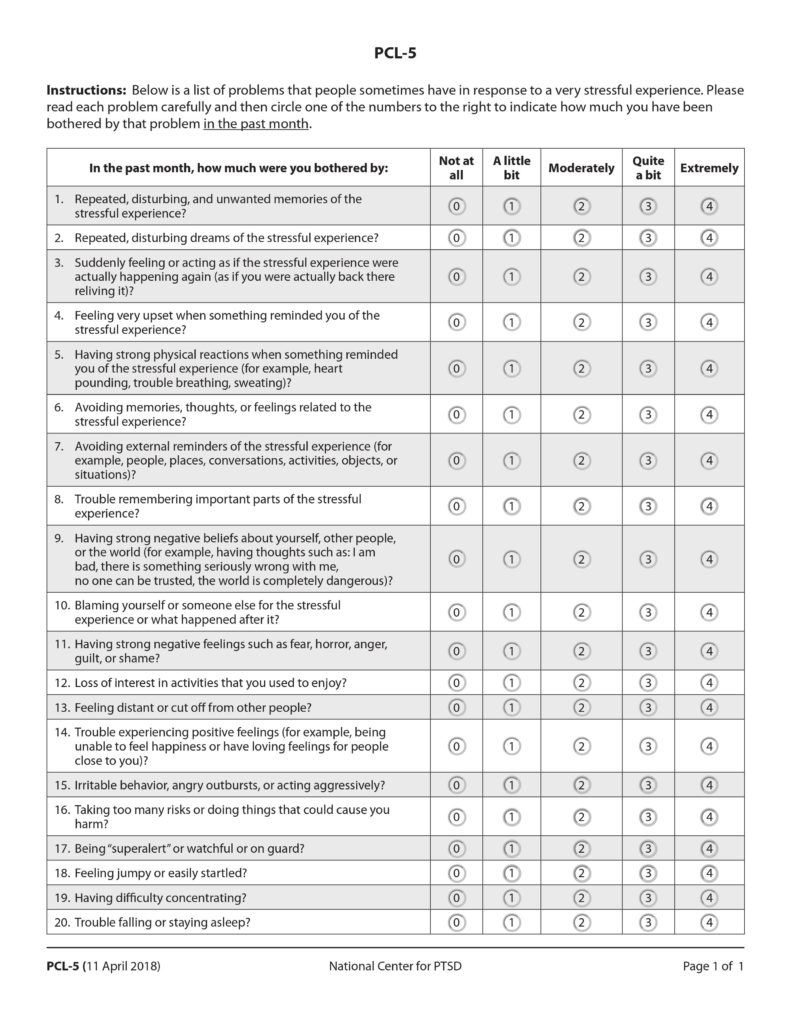LISTEN TO THIS ARTICLE:
Post Traumatic Stress Disorder is a stress disorder that occurs after experiencing a traumatic event. It causes people to feel emotionally numb, avoid reminders of the event, and experience flashbacks. It’s the most common trauma-related mental health issue and affects millions of Americans every year. Fortunately, there’s a useful and freely available PTSD test that you can take by yourself in just a few minutes.
What qualifies as trauma covers a wide range of experiences. Trauma from warfare is by far the most common source, appearing in up to 30% of military veterans. Trauma also comes from terror attacks, mass shootings, and natural disasters. Some job roles like EMTs, police, and fire fighters are at high risk, too. The final source is interpersonal violence in the form of child abuse, sexual assault, and abusive relationships.
All these different sources of trauma can make detecting and diagnosing PTSD a difficult and varied process. Add to that the extremely limited supply of mental health resources in America right now and you have a situation where many people have nowhere to go. However, there are several freely available PTSD tests that can help (including our own symptom checker!).
How do you test for PTSD?
There are several ways to test for PTSD, including self-assessment questionnaires, interviews, and psychological testing. The best, most validated questionnaire is called the “PCL-5,” short for “The PTSD Checklist for DSM-5.”
The PTSD test will ask questions about how often you think or feel certain symptoms. You should take the test when you first start feeling symptoms because the more you wait, the harder it becomes to recognize them as PTSD. If you do not answer honestly, the results might not be accurate.
The PCL-5 is a scientifically-validated, 20-question PTSD test that people can take by themselves without the guidance of a doctor or therapist. The test is meant to detect PTSD symptoms over the course of a month, so make sure to fill it out with that timeline in mind.
The questions in this test cover the 4 major categories of PTSD symptoms: intrusive thoughts and dissociation, triggering memories and avoidance behaviors, mood and mind changes, and physical symptoms and reactivity.
This part of the test is scored from 0 to 80. The general score cutoff is around 31-33 points. Scoring above that suggests that someone could benefit from PTSD treatment. Scoring below that indicates the presence of PTSD is less likely. Again, the results of this PTSD test are not final and need to be evaluated by a mental health professional.

You might also need to describe an event that caused you distress.
A traumatic event is any situation where someone experiences intense fear, helplessness, horror, or pain. This includes events such as being attacked by another person, witnessing violence, or having a natural disaster occur.
An extended version of this PTSD test goes into more detail regarding traumatic experiences. This is called the “PCL-5 with LEC-5 and Criterion A.” LEC stands for “Life Events Checklist” and contains questions that help define the types of trauma you have experienced.
Going through an extensive list like this one can be helpful to a lot of people who may have trouble identifying exactly what is causing their issues. Many people many not realize that things they have experienced were actually trauma. If everyone around you also experienced the same thing, it’s easy to view the events as ‘normal,’ when, in fact, they really are not. People around you may also have downplayed or outright denied the truth of what happened to you.
The Criterion A section builds on the same purpose of the LEC-5. This section encourages you to consider all of the stressful situations you have been through and focus on the worst. Exploring this event in detail will help clarify why it affects you so much and how. This offers a good step for jump starting the healing and growth process you’ll go through in therapy.
The PTSD test will then give you a score based on your answers.
If you think you might have experienced trauma, take the PTSD test. It’s free and takes less than 10 minutes. You’ll receive a score and find out how much support you need.
Just taking the test is not enough to rule in or rule out a diagnosis of PTSD. Instead, you can bring the test with you to a treatment provider. The results will help them make a diagnosis while they also consider multiple other factors, including life circumstances, impairments in functioning, and other medical or mental health issues. To find a therapist or doctor near you who specialized in trauma treatment, head to the WebShrink provider finder.